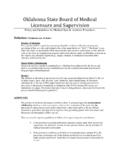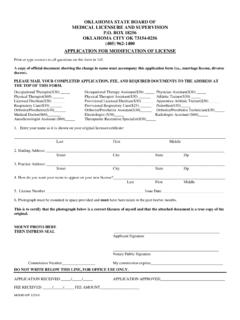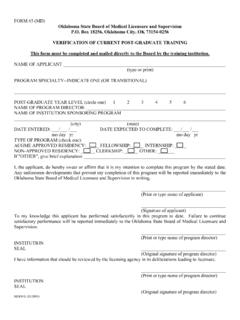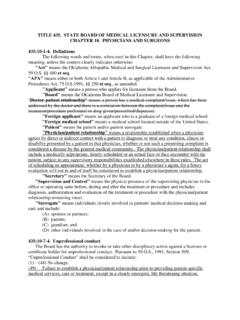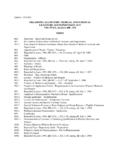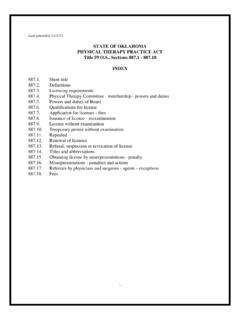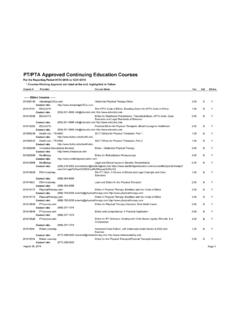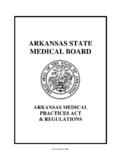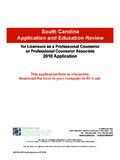Transcription of Board of Medical Licensure & Supervision 2010-2011
1 DON T WRITE Rx FOR TROUBLEA continuing frustration for the Oklahoma State Board of Medical Licensure and Supervision ( Medical Board ) Department of Investigations and Compliance is that all too many well-meaning Oklahoma physicians and PAs find themselves in trouble for unwittingly violating state and federal laws regarding the writing of prescrip-tions. Most prescribing problems are here s a quick primer on what physicians need to know before they write prescriptions. While much of the follow-ing information may seem elementary and simple common sense, the Medical Board Division of Investigations staff stresses that some Oklahoma doctors continue to make prescribing errors that could lead to Board action or even state and/or federal Criteria for Writing a Prescription: Oklahoma physicians can-not write a prescription without a sufficient examination and establishment of a valid physician/patient relationship.
2 The Board stipulates that the physician/patient rela-tionship cannot take place without an initial face-to-face encounter with the patient. During the initial encounter, physicians should verify that patients are who they claim to be and establish a diagnosis through accepted Medical practices such as history and physical, mental status exam and appropriate diagnosis and labo-ratory tests. Always, and under all cir-cumstances, be sure to make the reason for the prescription a part of the patient s Medical record. The Oklahoma Bureau of Narcotics and Dangerous Drugs (OBNDD) Regulation (B) states practitioners are required to keep readily retrievable records with respect to all Controlled Dangerous Substances (CDS) II-V which they pre-scribe, administer or dispense. Every time a prescription is issued, the chart docu-mentation should list the drug, strength, direction for use, quantity, reason ( , pain, anxiety, muscle spasms) and number of refills allowed.
3 In addition, PAs can only prescribe to patients who are within their and their supervising physician s practice. No pre-scriptions should be written to friends and fellow workers without a valid physician/patient relationship and maintenance of a Medical chart. Physicians and PAs are pro-hibited from writing prescriptions to self or specific family members. OAC 435:10704 (26) Valid Prescription Requirements: A prescription for a controlled substance must be dated and signed on the date issued. The prescription must be written in ink, indelible pencil or typed on pads meet-ing Federal guidelines and manually signed by the practitioner on the date issued. A secretary or other Medical professional may be designated by the practitioner to Continued on pg. 2 Vol. 18 Winter2010-2011 Issues&AnswersBoard of Medical Licensure & Supervisionthis issueDon t Write Prescriptions for Trouble P.
4 1 FAXing CDS Prescriptions P. 2 The Face-toFace Rule P. 4 Volunteering in Oklahoma P. 5 Board Meeting Actions P. 6 Prescription Monitoring Program Registration Call the PMP Helpline:1-877-627-2674or online physicians need to know about top 10 suggestions from enforcement s point of view A blank, signed prescription is not only illegal but the physician can never be sure for whom or what purpose it will be filled. prepare the prescription for his or her signature. The prescription must include the patient s full name and address, physi-cian s full name, address and DEA number, drug name and strength, dos-age form and quantity, and directions for use and number of refills if any are authorized. DEA has issued a letter stating that the prescriber must place the DEA number on the prescription. If the pre-scriber does not place the DEA number on the pre-scription, the pharmacist must call the physician and create a telephoned prescription.
5 The phar-macist may not add the DEA number to the origi-nal prescription. If the physician is not contacted by telephone, insurance auditors will declare the prescription invalid and recover all payment for the prescription from the pharmacy. Prescribing to Family Members: Except for a Medical emergen-cy when no other doc-tor is available, a physi-cian may NOT prescribe a Controlled Dangerous Substance (CDS) to him or herself, or any family member within the first two degrees of consan-guinity, , spouses, parents and children (first degree); and brothers, sisters, grandchildren and grandparents (second degree). Physicians MAY prescribe CDS to third degree relatives (nieces, nephews, aunts, uncles, great grandchildren and great grandparents) and below as long as a valid physician/patient relation-ship Sign a Blank Prescription: Federal law prohibits a physician from pre-signing prescriptions.
6 Prescriptions must be signed by the practitioner on the date issued. A blank, signed prescription is not only illegal but the physician can never be sure for whom or what purpose it will be and federal law enforcement officials take this law very seriously. In a worst case but real scenario, several years ago a Georgia physician pre-signed blank pre-scription sheets so that on the doctor s day off the office Nurse Practitioners could refill prescriptions for chronic pain patients. Federal agents raided the clinic and criminally prosecuted the physician. The physician lost his Medical license, served seven months in a fed-eral prison and was fined $30, It was almost three years before the physician had his medi-cal license reinstated and returned to Day Window for Schedule II Prescriptions: The Oklahoma Bureau of Narcotics and Dangerous Drugs (OBNDD) rules and regulations state that any prescription for Schedule II drugs becomes inval-id thirty (30) days after it is issued.
7 However, a physician who will be out of the office for an extended time may write a valid prescription for a Schedule II dated on the day of issue but stipulate on the prescription that it may not be filled until a future date within the Sign All FAXed Prescriptions for Schedule III, IV, V DrugsOklahoma physicians must manually sign all FAXed prescriptions for Schedule III, IV and V medications. JPG images or other types of electronically produced signatures on FAXed prescriptions are not valid and may put dispensing pharmacists and their institutions at financial , Requirement of Prescription, of the Federal Food, Drug and Cosmetic Act states a pharmacist may dispense a controlled substance listed in Schedule III, IV and V if received by FAX only if it is a facsimile of a signed paper prescription transmitted by the practitioner or the practitioner s agent to the pharmacy. While a pharmacist may dispense an oral prescription made by a practitioner and promptly reduced to writing by the pharmacist without the practitioner s signature and certain other electronically transmitted prescriptions, a FAXed prescription must be actually signed by the A.
8 Foust, Pharm. D., , Executive Director of the Oklahoma State Board of Pharmacy, reports some pharmacists are frustrated by being charged-back for non-manually signed FAXed prescriptions filled without calling the physician to create a telephoned prescription. He said hospital outpatient pharmacies are also at risk. Page 2thirty day window, , a prescription issued on March 1 is not to be filled until March Supervised Midlevel Practitioners: Under physician Supervision and within formularies, Physician Assistants (PA) and Nurse Practitioners (NP) may write prescrip-tions for Schedule III, Schedule IV and Schedule V medications. All prescriptions written by PAs or NPs must include the name and telephone number of the supervising physician. PAs and NPs may not write out-patient prescriptions for Schedule II drugs under any PAs nor NPs can dis-pense drugs but both can distribute and NP prescriptions for CDS III - V are limited to a thirty (30) day supply.
9 PAs may not issue orders that their supervising physicians are not allowed to may write orders for Schedule IIs for on-site administration based on written protocols or direct verbal order of supervising physician. Certified Registered Nurse Anesthetists (CRNA) may order and administer CDS II-V drugs but only during perioperative and/or periob-stetrical periods. Monitor Call-ins Closely: State and federal regulations allow physicians to designate agent(s) to call in prescriptions to pharmacists for CDS III-V drugs in order to make the prescription process more effi-cient. The Medical determination to prescribe the CDS can only be made by the practitioner, not the agent. The agent normally is an employee of the physician and may be a licensed Medical professional or even a non- Medical member of the office staff. Call-in prescriptions must meet all the criteria of a valid written prescrip-tion and must be noted in the patient s Medical record.
10 The physician is ultimately responsible and legally liable for all prescriptions called in under his or her name. Therefore, physicians should take great care in designat-ing, instructing and monitoring the staff member(s) allowed to call in prescriptions. Agency has legal meaning so physicians are encour-aged to have their office agents actually sign a document acknowl-edging their designation along with a brief description of their responsibility. The document should be kept on file in the office with copies distributed to the main pharmacies with which the physician deals. A sample copy of such a document is available by ask-ing Google for: Written Authorization for an Agent Recommended-Sample Agency Agreement. Physicians might want to notify pharmacies when the office agent no longer has the authority to call in prescriptions, espe-cially if there is any concern that the agent might try to continue to call in easiest way to monitor your office s call-in prescriptions is by regularly checking your prescrib-ing profile on the Oklahoma Bureau of Narcotics and Dangerous Drugs Prescription Monitoring Prescription Monitoring Program: The Oklahoma Bureau of Narcotics and Dangerous Drugs (OBNDD) Prescription Monitoring Program (PMP) is a national model for tracking CDS prescriptions in our state.
